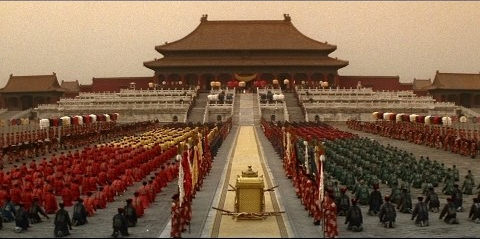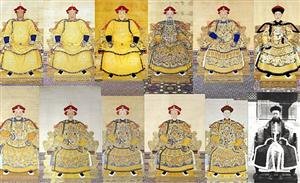Buy tickets for Danielle Wood on 4/22/2022 7:30 PM, CAMPBELL HALL . As the director of the cutting-edge Space Enabled research group at MIT’s Media Lab, Danielle Wood applies designs enabled by space research to projects that advance social good here on Earth. Presented by UC Santa Barbara Arts & Lectures.
— Read on artsandlectures.ucsb.edu/Details.aspx
Favorite Words to Pronounce in English
by Daniela Sofia Rosales Sanchez, Colombia
History of China
Written by, Sebastiaan Han, Netherlands
The earliest known written records of the history of China date from as early as 1250 BC from the Shang dynasty. Ancient historical texts such as the Records of the Grand Historian (c. 100 BC) and the Bamboo Annals (296 BC) describe a Xia dynasty (c. 2070–1600 BC) before the Shang, but no writing is known from the period, and Shang writings do not indicate the existence of the Xia.

The Xia Dynasty (2070-1600 BC)
The Xia dynasty is the legendary, possibly mythical first dynasty in traditional Chinese history. We never found any written records of this dynasty, but there are a few ancient texts which indicate the existence of this dynasty. The Xia dynasty was the first government to emerge in ancient China and became the first to apply to the policy of dynastic succession; and so making it the first dynasty of China
The Shang Dynasty (1600-1046 BC)
Archaeological findings providing evidence for the existence of the Shang dynasty, c. 1600–1046 BC, are divided into two parts. The first part, from the earlier Shang period, comes from sources at Erligang, Zhengzhou, and Shangcheng. The second part, from the later Shang or Yin period, is at Anyang, in modern-day Henan, which has been confirmed as the last of the Shang’s nine capitals (c. 1300–1046 BC).
The Zhou Dynasty (1046-256 BC)
This is the longest-lasting dynasty China has known. The Zhou dynasty began to emerge in the Yellow River Valley. They captured the territory that belonged to the Shangs. The Zhou lived west of the Shang, and the Zhou leader had been appointed Western Protector by the Shang. The ruler of the Zhou, King Wu, with the assistance of his brother, the Duke of Zhou, as regent, managed to defeat the Shang at the Battle of Muye.
The Zhou people were not invaders; they were Chinese-speaking people descendant from the Longshan Neolithic culture. During the course of several centuries, the Zhou moved away from barbarian pressures, migrating towards the westernmost agricultural basin of North China, the lower Wei River valley, present-day Shaanxi province. Here they began to develop Shang-style agriculture, and they also built a city in an area named Plain of Zhou, which gave its name to the state and the dynasty. The Shang ruling class considered the Zhou “semibarbarious country cousins”. For many years the Zhou and the Shang coexisted alternating peace and war.
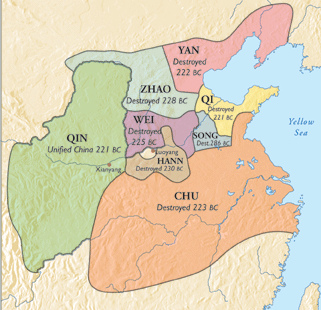
The Warring States period (476-221 BC)
After further political disagreements, seven prominent states remained by the end of 5th century BC, and the years consolidation in which these few states battled each other are known as the Warring States period. Though there remained a nominal Zhou king until 256 BC, he was largely a figurehead and held little real power.
Numerous developments were made during this period in culture and mathematics, examples include an important literary achievement, the Zuo Commentary on the Spring and Autumn Annals, which summarizes the preceding Spring and Autumn period and the bundle of 21 bamboo slips from the Tsinghua collection, which was invented during this period dated to 305 BC, are the world’s earliest example of a two digit decimal multiplication table, indicating that sophisticated commercial arithmetic was already established during this period.
As neighboring territories of these warring states, including areas of modern Sichuan and Liaoning, were annexed, they were governed under the new local administrative system of commandery and prefecture. This system had been used since the Spring and Autumn period, and parts can still be seen in the modern system of Sheng & Xian (province and county).
The final expansion in this period began during the reign of Ying Zheng, the king of Qin. After he got the approval and trust of Zhejiang, Fujian, Guangdong and Guangxi in 214 BC, this enabled him to call himself the First Emperor (Qin Shi Huang).
The Qin Dynasty (221-207 BC)
The Qin Dynasty is well-know because of the great Terracotta army. The Qin dynasty was the first dynasty of Imperial China, lasting from 221 to 206 BC. Named for its heartland in Qin state, the dynasty was founded by Qin Shi Huang, the First Emperor of Qin. The strength of the Qin state was greatly increased by the Legalist reforms of Shang Yang in the fourth century BC, during the Warring States period. In the mid and late third century BC, the Qin state carried out a series of swift conquests, first ending the powerless Zhou dynasty, and eventually conquering the other six of the Seven Warring States. Its 15 years was the shortest major dynasty in Chinese history, consisting of only two emperors, but created an imperial system that lasted, with interruption and adaptation, until 1912 CE.
The Han Dynasty (202 BC-220 AD)
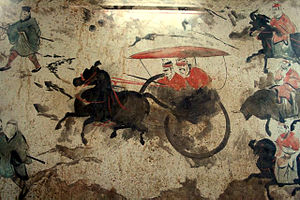
The Han Dynasty was founded by Liu Bang, who was victorious in the Chu–Han Contention that brought to the fall of the Qin dynasty. A golden age in Chinese history, the Han Dynasty’s long period of stability and prosperity created the foundation of China as a unified state under a central imperial bureaucracy, which was to last intermittently for most of the next two millennia. The Han Dynasty saw an age of economic prosperity and witnessed a significant growth of their economy first established during the Zhou dynasty (c. 1050–256 BC). The coinage issued by the central government mint in 119 BC remained the standard coinage of China until the Tang Dynasty (618–907 AD).
This in particular is a special era for me personally because my ancestors originate from China and specifically from the Han Dynasty. Before my family came to the Netherlands, they lived in Indonesia for many centuries. They came there from China to trade opium and to begin a new business. Several big Chinese families have been settled in Java for centuries, but so far very little has been done to investigate the social integration into the Javanese society and their part of the local economy, but my ancestors are traced back all the way to the 18th century and they played a significant part in the economic development of the “Oosthoek” or Eastern Salient. The family grew bigger and bigger until the Second World War. When the Japanese army came to Indonesia, they took almost everything from my family for their own usage. My grandfather decided to move to the Netherlands, but a lot of family members are still in Indonesia and other parts of the world.
Three Kingdoms (AD 220–280)
By the 2nd century, the empire declined amidst land acquisitions, invasions, and feuding between clans and eunuchs. The Yellow Turban Rebellion broke out in AD 184, happening in an era of warlords. In the ensuing turmoil, three states tried to gain predominance in the period of the Three Kingdoms.
After Cao Cao reunified the north in 208, his son proclaimed the Wei Dynasty in 220. Soon, Wei’s rivals, Shu and Wu, proclaimed their independence, leading China into the Three Kingdoms period. This period was characterized by a gradual decentralization of the state that had existed during the Qin and Han dynasties, and an increase in the power of great families.
In 266, the Jin Dynasty overthrew the Wei and later unified the country in 280, but this union was short-lived.
The Jin Dynasty (AD 266-420)
The Jin Dynasty or the Jin Empire was a Chinese dynasty traditionally dated from 266 to 420. It was founded by Sima Yan, son of Sima Zhao, who was made Prince of Jin and declared the founder of the dynasty. It followed the Three Kingdoms period, which ended with the conquest of Eastern Wu by the Jin.
The Jin Dynasty was severely weakened by internecine fighting among imperial princes and lost control of northern China after non-Han Chinese settlers rebelled and captured Luoyang and Chang’an. In 317, a Jin prince in modern-day Nanjing became emperor and continued the dynasty, now known as the Eastern Jin, which held southern China for another century. Prior to this move, historians refer to the Jin Dynasty as the Western Jin.
The Sui Dynasty (AD 581-618)
The Sui Dynasty was a short-lived imperial dynasty of China of great significance. The Sui unified the Northern and Southern dynasties and reinstalled the rule of ethnic Han Chinese in the entirety of China proper, along with the reuniting of former nomadic ethnic people within its territory.
A lasting legacy of the Sui Dynasty was the Grand Canal. With the eastern capital Luoyang at the center of the network, it linked the west-lying capital Chang’an to the economic and agricultural centers of the east towards Hangzhou, and to the northern border near modern Beijing. While the pressing initial motives were for shipment of grains to the capital, and for transporting troops and military logistics, the reliable inland shipment links would facilitate domestic trades, flow of people and cultural exchange for centuries.
The Tang Dynasty (AD 618–907)
The Tang Dynasty was founded by Emperor Gaozu on 18 June 618. It was a golden age of Chinese civilization and considered to be the most prosperous period of China with significant developments in culture, art, literature, particularly poetry, and technology. Buddhism became the predominant religion for the common people. Chang’an (modern Xi’an), the national capital, was the largest city in the world during its time.
Underlying the prosperity of the early Tang Dynasty was a strong centralized bureaucracy with efficient policies. The government was organized as “Three Departments and Six Ministries” to separately draft, review, and implement policies. These departments were run by royal family members as well as scholar officials who were selected by imperial examinations. These practices, which matured in the Tang dynasty, were continued by the later dynasties, with some modifications.
Five Dynasties and Ten Kingdoms (AD 907–960)

The period of political disunity between the Tang and the Song, known as the Five Dynasties and Ten Kingdoms period, lasted from 907 to 960. During this half-century, China was in all respects a multi-state system. Five regimes, namely, Liang, Tang, Jin, Han and Zhou, rapidly succeeded one another in control of the traditional Imperial heartland in northern China. Among the regimes, rulers of Tang, Jin and Han were sinicized Shatuo Turks, which ruled over the ethnic majority of Han Chinese. More stable and smaller regimes of mostly ethnic Han rulers coexisted in south and western China over the period, cumulatively constituted the “Ten Kingdoms”.
Amidst political chaos in the north, the strategic Sixteen Prefectures (region along today’s Great Wall) were ceded to the emerging Khitan Liao Dynasty, which drastically weakened the defense of the China proper against northern nomadic empires. To the south, Vietnam gained lasting independence after being a Chinese prefecture for many centuries. With wars dominated in Northern China, there were mass southward migrations of population, which further enhanced the southward shift of cultural and economic centers in China. The era ended with the coup of Later Zhou general Zhao Kuangyin, and the establishment the Song dynasty in 960, which eventually annihilated the remains of the “Ten Kingdoms” and reunified China.
Yuan Dynasty (AD 1271–1368)
The Yuan Dynasty, officially the Great Yuan, was the empire or ruling dynasty of China established by Kublai Khan, leader of the Mongolian Borjigin clan. It followed the Song Dynasty and preceded the Ming Dynasty.
Genghis Khan and his sons set the foundation for the Yuan Dynasty by defeating the Western Xia and conquering Central Asia, Mongolia, and the Hexi Corridor. This gave them a base of manpower, horses, technology, and experience to finish the conquest of the fierce Jin army and then to go on and conquer the Dali empire and the Song empire.
Genghis Khan died in 1227 and had named his son, Ogedei, to be the next emperor. Ogedei was said to rule the whole Mongol empire from 1229 to 1241, but he concentrated his efforts in the eastern part of it. In 1232, he invaded the Jin Empire in alliance with the Song Empire. Jin was defeated in 1234. From 1235, Ogedei started a campaign with the Song Dynasty.
Kublai was a grandson of Genghis Khan. He had a comparatively long rule and reformed the empire to increase his power and make the empire prosper.
In 1253, he captured the Dali Kingdom in Yunnan Province.
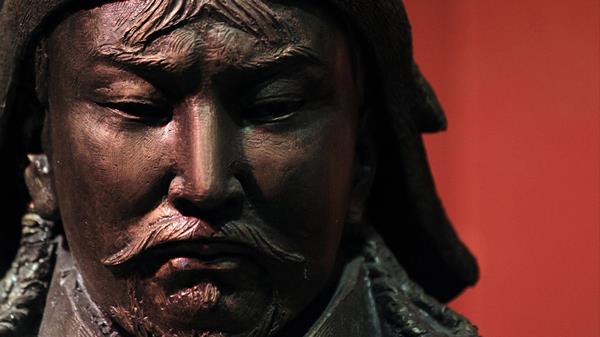
In 1259, Kublai campaigned against the Southern Song Dynasty.
In 1260, Kublai took the throne after his elder brother, Mongke, died.When he heard that his elder brother, who was the Great Khan Mongke, had died, he and another brother went to war. Both of them wanted to be the Khan.
They fought a series of battles and Kublai won. This caused a division in the Mongol Empire. The Golden Horde that controlled the area of Russia and Chagatai Khanate did not recognize Kublai Khan as their ruler.
Kublai sent large armies against the Song people in the 1270s. In 1276, the Mongols captured the Song capital of Hangzhou and most of the Song Dynasty clan. However, two young brothers of the captured Song emperor escaped and went south.
In 1227 , the Song Dynasty court fled to Quanzhou. They were attacked there by a rich Muslim merchant. They fled again to Hong Kong and the court attempted to make a stand there in 1279, but they were soundly defeated by the Mongols. The last emperor died there at the age of 9 in 1279.
The Ming Dynasty (AD 1368-1644)
The Ming dynasty was the ruling dynasty of China – then known as the Great Ming Empire – for 276 years following the collapse of the Mongol-led Yuan dynasty. The Ming dynasty was the last imperial dynasty in China ruled by ethnic Han Chinese.
Urbanization increased as the population grew and as the division of labor grew more complex. Large urban centers, such as Nanjing and Beijing, also contributed to the growth of private industry. In particular, small-scale industries grew up, often specializing in paper, silk, cotton, and porcelain goods. For the most part, however, relatively small urban centers with markets proliferated around the country. Town markets mainly traded food, with some necessary manufactures such as pins or oil.

The Ming Dynasty intervened deeply in the Japanese invasions of Korea (1592–98), which ended with the withdrawal of all invading Japanese forces in Korea, and the restoration of the Joseon Dynasty, its traditional ally and tributary state. The regional hegemony of the Ming dynasty was preserved at a toll on its resources. Coincidentally, with Ming’s control in Manchuria in decline, the Manchu (Jurchen) tribes, under their chieftain Nurhaci, broke away from Ming’s rule, and emerged as a powerful, unified state, which was later proclaimed as the Qing dynasty. It went on to subdue the much weakened Korea as its tributary, conquered Mongolia, and expanded its territory to the outskirt of the Great Wall. The most elite army of the Ming dynasty was to station at the Shanhai Pass to guard the last stronghold against the Manchus, which weakened its suppression of internal peasants uprisings.
Qing Dynasty (AD 1644–1911)
The Qing Dynasty, officially the Great Qing, was the last imperial dynasty of China. It was established in 1636, and ruled China proper from 1644 to 1912. It was preceded by the Ming Dynasty and succeeded by the Republic of China.
The Qing Dynasty (1644–1911) was the last imperial dynasty in China. Founded by the Manchus, it was the second conquest dynasty to rule the entire territory of China and its people. The Manchus were formerly known as Jurchens, residing in the northeastern part of the Ming territory outside the Great Wall. They emerged as the major threat to the late Ming Dynasty after Nurhaci united all Jurchen tribes and established an independent state. However, the Ming Dynasty would be overthrown by Li Zicheng’s peasants rebellion, with Beijing captured in 1644 and the Chongzhen Emperor, the last Ming emperor, committing suicide.
In response to calamities within the empire and threats from imperialism, the Self-Strengthening Movement was an institutional reform in the second half of the 1800s. The aim was to modernize the empire, with prime emphasis on strengthening the military. However, the reform was undermined by corrupt officials, cynicism, and quarrels within the imperial family. As a result, the “Beiyang Fleet” were soundly defeated in the First Sino-Japanese War (1894–1895). The Guangxu Emperor and the reformists then launched a more comprehensive reform effort, the Hundred Days’ Reform (1898), but it was soon overturned by the conservatives under Empress Dowager Cixi in a military coup.
At the turn of the 20th century, the violent Boxer Rebellion opposed foreign influence in Northern China, and attacked Chinese Christians and missionaries. When Boxers entered Beijing, the Qing government ordered all foreigners to leave. But instead the foreigners and many Chinese were besieged in the foreign legations quarter. The Eight-Nation Alliance sent the Seymour Expedition of Japanese, Russian, Italian, German, French, American, and Austrian troops to relieve the siege. The Expedition was stopped by the Boxers at the Battle of Langfang and forced to retreat. Due to the Alliance’s attack on the Dagu Forts, the Qing government in response sided with the Boxers and declared war on the Alliance. There was fierce fighting at Tientsin. The Alliance formed the second, much larger Gaselee Expedition and finally reached Beijing; the Qing government evacuated to Xi’an. The Boxer Protocol ended the war.
Modern China
Republic of China (since 1912)
Frustrated by the Qing court’s resistance to reform and by China’s weakness, young officials, military officers, and students began to advocate the overthrow of the Qing dynasty and the creation of a republic. They were inspired by the revolutionary ideas of Sun Yat-sen. A revolutionary military uprising, the Wuchang Uprising, began on 10 October 1911, in Wuhan. The provisional government of the Republic of China was formed in Nanjing on 12 March 1912. The Xinhai Revolution ended 2,000 years of dynastic rule in China.
After the success of the overthrow of the Qing Dynasty, Sun Yat-sen was declared President, but Sun was forced to turn power over to Yuan Shikai, who commanded the New Army and was Prime Minister under the Qing government, as part of the agreement to let the last Qing monarch abdicate (a decision Sun would later regret). Over the next few years, Yuan proceeded to abolish the national and provincial assemblies, and declared himself emperor in late 1915. Yuan’s imperial ambitions were fiercely opposed by his subordinates; faced with the prospect of rebellion, he abdicated in March 1916, and died in June of that year.
Yuan’s death in 1916 left a power vacuum in China; the republican government was all but shattered. This ushered in the Warlord Era, during which much of the country was ruled by shifting coalitions of competing provincial military leaders.
In 1919, the May Fourth Movement began as a response to the terms imposed on China by the Treaty of Versailles ending World War I, but quickly became a nationwide protest movement about the domestic situation in China. The protests were a moral success as the cabinet fell and China refused to sign the Treaty of Versailles, which had awarded German holdings to Japan. The New Culture Movement stimulated by the May Fourth Movement waxed strong throughout the 1920s and 1930s.
Sources:
Wikipedia
The Effects of Cyber Bullying in Adolescents
Luciana Pesce, Chile
All the teenagers in our society have a mobile phone that allows them to be permanently connected in social networks, but if used incorrectly also can bring serious problems. Nowadays cyber bullying occurs very frequently with teenagers. This a very substantial problem because this can lead to depression, anxiety, impotence and even suicide. Cyber attacking can be very bad for the person affected by this, because it influences their self-esteem and spreading rumors and intimidation is nothing good. Also this type of bullying is particularly worrying because it is constant, general and very, very public.

Firstly, cyber bullying can occur at all times and affect the mental health of adolescents to have depression and isolate themselves from their responsibilities, family and friends, leaving them helpless to the insults directed towards them. To show that, many teenagers end up committing suicide since they can no longer live with the insults, or being humiliated, and even the harassed cannot afford to rest from the fear when they arrive at home or anywhere else away from the environment of their stalker.
Furthermore, once published, the content shared on social media and instant messaging applications become uncontrollable, making it impossible for the victim to know who the message has reached or if it will be repeated. As a result of this, the harassed person does not know when or by whom he will be bothered, generating anguish and the desire to end everything around him to feel relieved.

Finally, the victim hides his situation as a result of the shame, until he even think that he is to blame for what is happening to him, and think what they say about him is true. This leads to parents not knowing what is happening to their child, and that they try to solve it without any positive results. If the parents knew, they could solve it with psychological or even legal help, getting beneficial results for their child.

As I said before, cyber bullying is very bad, but there are some ways to prevent it. The first one is to talk with the kid about what is cyber bullying, if he knows someone who is being bullied and what the child should do if notices acts of bullying. Secondly, parents should monitor social media activity, including Facebook and Instagram, view all text messages, call logs and general online behavior.
There is no simple solution to cyber bullying or the best way to handle a bully, but, since cyber bullying is rarely limited to one or two incidents, it’s far more likely to be a sustained attack over a period of time. But you can handle it with not blaming yourself, do not beat yourself up, try to view bullying from a different perspective. Report the threats of harm. Do not seek revenge or do not respond to any messages or posts.
Why Danes are The Happiest People on Earth
Louise Mohr, Denmark

Again this year the Danish people are dominating the World’s Happiness Report and ranks among the top three happiest of 155 countries surveyed. On the other hand, the U.S. is with a four-spot drop, ranked 18th this year.
So why is it that these pastry-loving, LEGO building people are winning the happiness race? And how do they compare to the States?
The Danish welfare state works.
Danes pay some of the highest income tax rates in the world (45% on average), but, in exchange, every Dane gets free health care, free K-college education (the students are paid approx. $900 a month by the government to go to school), highly subsidized child care and generous unemployment benefits.
Some might lift an eyebrow over the high tax-rate, but the Danes don’t look at the tax rate as a burden, but as an investment in our society and quality of life.
If you lose a job in Denmark, it’s not a big deal. Unemployment is built into the system. This is in connection to the “flexibility model”, which, quickly explained, is a system built on freedom for employees. The government programs retrain workers and position them better for the job market. By doing this, we create strong connections and also provide a guaranteed safety net, giving unemployment benefits for up to two years.
The government also has a great retirement system, providing for the elders over 65+ population through a combination of state-founded pension and private employer-funded pension programs. This not only relieves the stress for the elderly, but makes them feel secure about their retirement.
Here’s a video that explains further: https://www.youtube.com/watch?v=095ULhvaH5E
The perhaps most important aspect of the Danish culture is “hygge”, which they value as a cultural construct. It refers to high-quality social interactions. It’s used as as a noun, adjective or verb, and events and places can also be “hyggelige” (hygge-like). “Hygge” is most commonly translated as “cozy”, but is more an intentional intimacy, which can happen when you have safe, balanced and harmonious shared experiences.
“Hygge” is the Danish sense of well-being. Although Denmark is a highly individualized country, “hygge” promotes egalitarianism and strengthens the trust between people. It’s fair to say that “hygge” is fully integrated into the Danish culture psyche and culture.
But Denmark is not the only country that has a concept similar to hygge – the Norwegains have “koselig”, the Swedes “mysig”, the Dutch “gezenlligheid” and the Germans “gemütlichkeit”.
The U.S. also places a high value on individualism, but there’s no real cultural equivalent of “hygge”. Income is generally associated with happiness. Even though the GDP is on the rise and the unemployment has been declining, levels of happiness in the U.S. have been steadily decreasing.
The U.S. income also continues to be an issue. There’s been a marked decrease in interpersonal trust toward institutions like the government as well as the media.
At it’s core, “hygge” is about building trust and intimacy with others. Americans could probably use a little more of that in their lives.
As a Dane in America, i find the the lack of free healthcare the most problematic. The United States reminds to be the only industrialized country in the world that fails to provide universal healthcare for all citizens. The concerns regarding this are significant and continues. Most people here are scared to get sick, and because of the high cost they avoid the doctors. American healthcare is the source of innumerable issues for many, both those withe and without coverage. These issues are not limited to the financial prospect, but has a far-reaching influence on their quality of life, psychological stability, and fundamental happiness for society at large.
After spending 3 months here, i can vouch for the rudimentary differences between America and Denmark. The divergences extend beyond policy, logistics or political agendas. There is a complete different feel to the place, a different tone to the culture on a fundamental level. I truly believe that America could learn something extremely vulnerable form the danish culture, if they had the trust to do so.
How to Maintain a Healthy Lifestyle
Luna, Belgium
Having a healthy lifestyle starts with a healthy mindset. You need to be in peace with yourself to be able to have access to that stable lifestyle you want. It’s all about finding that balance between self-care and allowing yourself to have a treat. It is important to know how your body works and how to improve your way of living.
The motivation and will to become healthy comes from within and you are the only person controlling your body. If you really want it, go and get it. It is as simple as that. You have to find certain sources of motivation to keep track of that lifestyle you want to achieve. As long as your mindset is in a good place, you will be, too !

One of the first things that is crucial to know and that you’ve probably heard a billion of times is drinking water. It makes you feel cleansed 24/7 and it is recommended to drink 180 ml per day. It will keep your system going and your skin clear!

Eating healthy always sounds so boring and like it’s something you have to endure, but it is way more easy and delicious than it sounds. You can find tons of easy recipes online that are so healthy and really tasty. Another way to achieve health in general is finding healthier options for things like butter, sugar and other harmfull products we might use a little too much. Coconut oil, Agave syrup are way better options for those two examples. Try to include plant-based products as much as you can in your diet because those are the most beneficial food sources you can eat. Vegetables and fruits are really important but, they’re not the only ones out there ; quinoa, all kinds of rice, grains, beans, lentils … are fibers and protein sources that are so easy to make, way healthier and better for the environment than meat or fish.

After you get your diet down and decide which kinds of food are working for you and your inner body, you need to focus on your body image. That is where exercise will become part of your routine. Try to find ways you like to exercise because going to the gym is not always a pleasure for everyone. Dancing, hiking, yoga, swimming sounds like fun to me and are really nice activities you can do with other people.
Finally, you need to see this as a better way of living and not a restrictive way of living. You need to enjoy it in order to maintain it. That’s why balance is the most important thing. You should be able to treat yourself, but have a healthy lifestyle in general.
Animals Facing Extinction
by Malena Julia Banjavcic, Switzerland
Help. What does help mean? Who needs help? And what help do they need? What can we do to help? These are questions we should ask ourselves every day. We are not alone in this world, even if it sometimes feels like it. There are people, who need help, but also animals. And we all need to start to ask ourselves how to make a change, because there are animals facing extinction and their time is running out.
So what does it mean when animals are in real danger facing extinction?
Plants and animals which are facing extinction are called Endangered Species. Particularly, it says that these species are very likely to become extinct in nearer time. Of course, there are reasons in nature why animals become endangered, but for the most part we, humans, are the reason. Evidence of this is provided by the International Union for Conservation of Nature (IUCN). According to it, we are now losing animal species at more than 1,000 times the normal rate. In 2012, the IUCN featured 3,079 animals and 2,655 plants as endangered worldwide. Whereas back in 1998, the figures were 1,102 animals and 1,197 plants. People often don’t even know that animals, which are well known, are critically endangered. Examples of species which are facing extinction are the Amur Leopard (pic. 1), the Bornean Orangutan (pic. 2) or the Malayan Tiger (pic. 3).
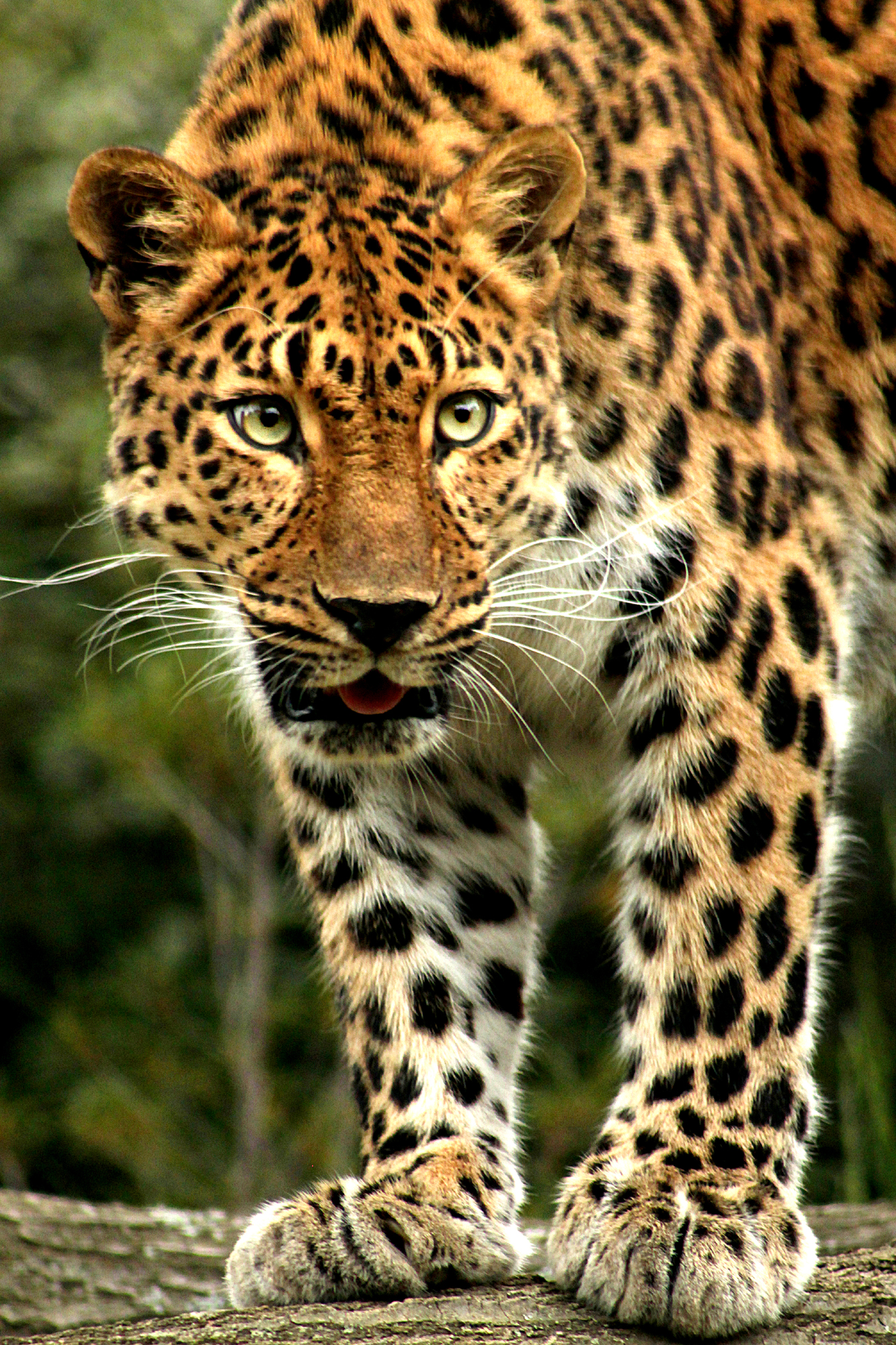 (pic. 1)
(pic. 1)  (pic. 2)
(pic. 2)  (pic. 3)
(pic. 3)
If nothing changes, we put ourselves in danger, too. The world is a whole, big ecosystem. Ecosystems depend on healthy plants and animals. Without them an ecosystem is not even possible; they are the foundation. When one of the species becomes endangered, the whole system slowly starts to fall apart. So every loss of a species triggers the next. Just like animals and plants, we, humans, also depend on healthy ecosystems like forests, oceans or grasslands. So we’re risking our health and environment when we don’t do anything about the contamination.
We, humans, cause the extinction of a lot of species only by living, but this can be changed. We have to live together with the animals. I once heard someone saying “it’s not our world, we just borrowed it” and I think that is the truth.
I think something important to do is to educate. We need to teach people and especially children about what is happening right now. If people do not know about the problem, they can’t do anything, but it’s also the job of our governments. How do people still sell furs and skins of all these endangered animals without being punished for it? Another thing which helps, is ,of course, the support for several organisations which work on this problem. Support can mean financial for those, who either don’t have the time or the will to go to the affected places where help is needed, but volunteer work is also support. Not only do you help, but you also experience beautiful countries and learn something about our world, the different cultures and also about yourself. “Work” doesn’t always mean it’s not fun.
It’s not that difficult to change something, so why isn’t there a change going on? – Ask yourself.

sources:
- https://faunalytics.org/endangered/?gclid=Cj0KCQjwrszdBRDWARIsAEEYhrdw31M8OWsEchW233z02sL1IFJq_RtySMcMF1aLOoN3BHwP1cI3B9AaAtnREALw_wcB
- https://en.wikipedia.org/wiki/Endangered_species#IUCN_Red_List
- https://www.worldwildlife.org/species/directory?direction=desc&sort=extinction_status
- http://www.endangered.org/importance-of-the-endangered-species-act/
Social Medias: Suggestions for Teens’ Everyday Life
Maria Pia De Felice, Italy
Social medias are nowadays’ most popular apps on our mobile phones. If you’re not subscribed to at least one famous social media, you may look strange to others and they may judge you (for example, saying that you’re asocial). As well, if you have very few photos posted on your profile, they may think that you’re ugly and that you don’t want to show yourself.

But whatever you do, you can be judged by the community: for example, people may not like what you post and could make fun of you when they are looking at it. As well, someone could use your photos pretending to be you!
After talking about all of this… Are social medias worth it? Are they a good way to interact with people, or are they just a waste of time?
First of all, in order to avoid letting someone use your profile, you must put it in private mode: what does it mean? You can “lock” your profile so that others can’t see your profile without your permission. If they want to, they can send you a friend request, then you can accept or decline it. I recommend you to not accept strangers’ friend requests, but just your friends’ ones.
Another thing I recommend for your own security is to not post intimate information about your friends, family and yourself, such as your address, your email, your mobile number. The same suggestion goes for your photos: never show parts of your body that nobody should see!

Social medias are a good way to meet and chat with people you used to know, or that, at the moment, live far away from you. So you must know that if you’d like to keep in touch with them, social medias are the best way to do it!
At the end, remember that everything you do is your own choice: the world is free and you can do whatever you want, but these suggestions are just for your safety!
If you want to go deep into this topic, check the video below!
easy consumerism
By Jeanne Beaudoin from France
Consumerism is the protection or promotion of the interests of consumers and the preoccupation of society with the acquisition of consumer goods. What is the great danger of consumerism today? First of all, we will talk about the danger of consumerism for each one, and then we will talk about how consumerism is dangerous for the world.

The society is dangerous for every mind because everything is too easy: we want tomato; we just have to go to a shop and buy tomato. Everything we want is possible because of the consumerism. This facility is negative for everybody because we become selfish; we are just some complacent yet covetous heart. We don’t know the real difficulty; everything is served on a silver platter. We’ve never have to fight to eat, to drink water, to take a shower… Everything we need is available. And because everything we need is given, we are every time searching something better, something we can’t have. We cannot appreciate a glass of water because it is unlimited. We are eternally unsatisfied. We do everything for our own interest and it is always difficult to do something if it is against our own inte
rest. Why would I like help each other if it’s difficult and if I can stay in front of my TV? Consumerism cut our interest for the world off. It is very dangerous because often some people never realize this. But, it is also dangerous for the world.
Consumerism is da ngerous for everybody because it gives us everything we want, letting some people being selfish. But it is also dangerous for our environment. Due to consumerism, the world is going to die slowly. To have beautiful clothes and furniture we kill lots of sheep, elephants, snakes and other animal species extinctions have happened at times. To give us lots of paper, we create deforestation. It is very selfish because we won’t have enough oxygen since trees are lungs of the Earth. Consumerism entrains climate change from the smog of enterprises and powerful countries. Consumerism also creates a big difference between rich and poor people. When someone is poor it is very difficult for him to leave this circle of poverty. Poor countries have lots of difficulties to live next to very rich countries because of this consumerism. It’s almost impossible to become a rich country for a poor country because rich countries try to steal their wealth (petroleum…).
ngerous for everybody because it gives us everything we want, letting some people being selfish. But it is also dangerous for our environment. Due to consumerism, the world is going to die slowly. To have beautiful clothes and furniture we kill lots of sheep, elephants, snakes and other animal species extinctions have happened at times. To give us lots of paper, we create deforestation. It is very selfish because we won’t have enough oxygen since trees are lungs of the Earth. Consumerism entrains climate change from the smog of enterprises and powerful countries. Consumerism also creates a big difference between rich and poor people. When someone is poor it is very difficult for him to leave this circle of poverty. Poor countries have lots of difficulties to live next to very rich countries because of this consumerism. It’s almost impossible to become a rich country for a poor country because rich countries try to steal their wealth (petroleum…).
In conclusion, we can say than consumerism is negative from every point of view. I hope in the future we will find a solution to have less selfish people and a better world.

Should animals be used for scientific and commercial testing? by Stella, Germany

General information:
An estimated 26 million animals are used every year in the US for commercial and scientific testing including mice, rats, fish, birds, guinea pig, farm animals, cats and dogs.
They are used to develop medical treatments, determine the toxicity of medications, check the safety of products destined for human use.
In additon, to the torment of the actual experiments, animals in laboratories are deprived of everything that is important and natural to them.
They are confined to barren cages, socially isolated and psychologically traumatized.
Most of the torture is legal.
Legal tests include: burning, poisoning, starving, forced, smoking, mutilating, blinding, electrocuting, drowning and dissecting without painkillers. They also get cut open without any painkillers.
The reality is that the majority of animal experiments do not contribute to improving the human health.
AGAINST the scientific and commercial testing
Many organizations try to follow the three R rules to improve the torment of the animals using for scientific and commercial testing:
Replacement
replacing animals with non-animals tests
Reduction
using fewer animals to do research
Refinement
emphazies the fact, that if companies are going to use animals for your research, they have to make sure that those animals are treated at the highest (ethical) level
Alternatives to replace animals in science:
- in vitro (test tube) test methods and models based on human cell and tissue cultures
- computer models and simulations
- stem cell and genetic testing methods
- microdosing (in which humans are given very low quantities of a drug to test the effects on the body on the cellular level, without affecting the whole body system)
Why is replacing animals in science much better than using animals for testing? Are there any advantages in non-animal testing?
Yes, replacing animals in science with different alternatives has several advantages.
It is cheaper, faster and companies can test more chemicals.
It is not only more effective for science, but also more reliable and more human.



PRO the scientific and commercial animal-testing
- Animals themselves benefit from the results of animal testing
- If vaccines were not tested on animals, millions of animals would have died from rabies, distemper, feline leukemia, infectious hepatitis virus, tetanus, anthrax, and canine parvo virus.
- Treatments for animals developed using animal testing also include pacemakers for heart disease and remedies for glaucoma and hip dysplasia.
- Animal testing has also been instrumental in saving endangered species from extinction, including the black-footed ferret, the California condor and the tamarins of Brazil.


